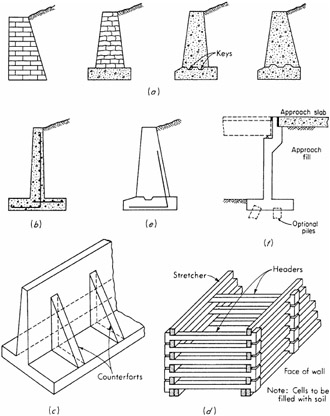Ace Construction Company - An Overview
Table of ContentsAn Unbiased View of Austin Construction CompanyAce Construction Company Things To Know Before You Get ThisAce Construction Company Can Be Fun For AnyoneHow Ace Construction Company Austin can Save You Time, Stress, and Money.
Because these products can not withstand appreciable tension, the style targets at avoiding tension in the wall. Some gravity walls do not utilize mortar, relying entirely on their weight to stay in location, as in the case of dry stone walls. These walls usually are trapezoidal in area as displayed in Fig.2. Gravity walls require heavy structure due to the large size of the wall. They are affordable and ideal for only small heights (Ace Construction Company). A gravity keeping wall provided with a percentage of reinforcement for minimizing the mass of the concrete is understood as semi-gravity keeping wall, as displayed in Fig.
3. The lateral earth pressure is primarily resisted by the mass of the wall, as when it comes to a gravity maintaining wall. These are the reinforced concrete walls in which lateral earth pressure is withstood by structural action of its members. The base of the wall is extended into the backfill on the heel side and is referred to as heel piece, as displayed in Fig.
4. The backfill over the heel piece provides significant extra lateral stability to the wall. The back of the wall on the heel side is likewise offered a slope. This increases the width of the wall with depth, similar to the boost in lateral earth pressure with depth. The vertical wall (called stem), the heel piece, and the toe slab serve as cantilevers fixed at their junction and spanning to the other end.
The Ace Construction Company Texas Ideas

The heel piece and the toe piece go through resultant upward soil pressure from the bottom and bend upward. Reinforcement is therefore offered on the stress side, that is, vertically on the behind of the stem and horizontally at the bottom of the heel piece and the toe piece.
Cantilever maintaining walls appropriate for maintaining the backfill to moderate heights of 4-7 m. In random sample, most cantilevered walls look like "L" s or inverted "T" s. Where structure soils are bad, earth tieback maintaining walls are another option. These walls are reversed not only by a large base but likewise by a series of horizontal bars or strips extending out from the vertical surface into the backfill.
As soon as an earth tieback retaining wall is backfilled, the weight and friction of the fill against the horizontal members anchors the structure. When the height of a cantilever maintaining wall is more than about 7 m, it is affordable to provide a vertical bracing system, called counterforts, on the backfill side above the heel piece.
16. 5. The stem and the heel slab serve as constant slabs spanning horizontally along the length of the wall between the counterforts. Using counterforts reduces the bending minute due to earth pressure and thus the size and support of the stem and the heel piece. Counterforts are subjected to stress due to the action of lateral earth pressure of the backfill on the stem.
Everything about Austin Construction Company
Figure 16. 6 reveals an upheld retaining wall. The structural action of the stem is the exact same as in a counterfort keeping wall. Nevertheless, the heel slab functions as a cantilever slab as in a cantilever maintaining wall. The toe slab serves as a continuous piece covering along the length of the wall between the buttresses.
ADVERTISEMENTS: Sheet stacks are versatile maintaining structures utilized to provide a short-lived building and construction area for building of structures. Sheet stacks are made from wood, steel, or often enhanced concrete. Timber sheet piles were used in the past but their reuse is restricted for short-term structures up to shallow depth. For very important structures and for depth > 3 m, steel sheet stacks are more frequently utilized.
Strengthened cement concrete (RCC) sheet stacks may be in some cases used in fine sand or soft clays. RCC piles might get damaged or broken under driving tensions in stiff soils. Sheet piles are installed by first driving the steel or wood sheets into the soil. The soil on the front side is navigate here then dug up (eliminated) out.


The Best Guide To Ace Construction Company Austin
Thus, the depth of structure (embedment) is big compared with that in a retaining wall. The thickness of sheet piles is really small compared to the depth and length of a wall. Thus, the weight of a sheet pile is very little and is generally disregarded in the style. ADVERTISEMENTS: The soil on the back of the sheet pile is generally eliminated and backfilled with a cohesionless soil. Ace Construction Company Austin.
Nevertheless, the soil below the dredge level may be either a cohesionless soil or a cohesive soil, depending on the soil profile at the website of building and construction - Ace Construction Company. Sheet piles having water on the front side used in dock and harbor structures to assist in berthing of vessels (ships) are called bulk heads.
Standard sections of steel sheet stacks as suggested by US Steel (1984) are displayed in Table 16. 3. i. Cantilever sheet stack. ii. Anchored go to this website sheet pile. The cantilever sheet stack obtains its assistance from the embedment into the underlying visit soil listed below the dredge level, as shown in Fig. 16. 11.
When it comes to anchored sheet piles, extra lateral assistance is offered by ways of anchor rods fixed to the sheet pile near the top and anchored suitably, as shown in Fig. 16. 12. The lateral stability of anchored sheet stacks is derived both from the embedment into the soil below the dredge level as well as by the support offered by the anchor or tie rod.